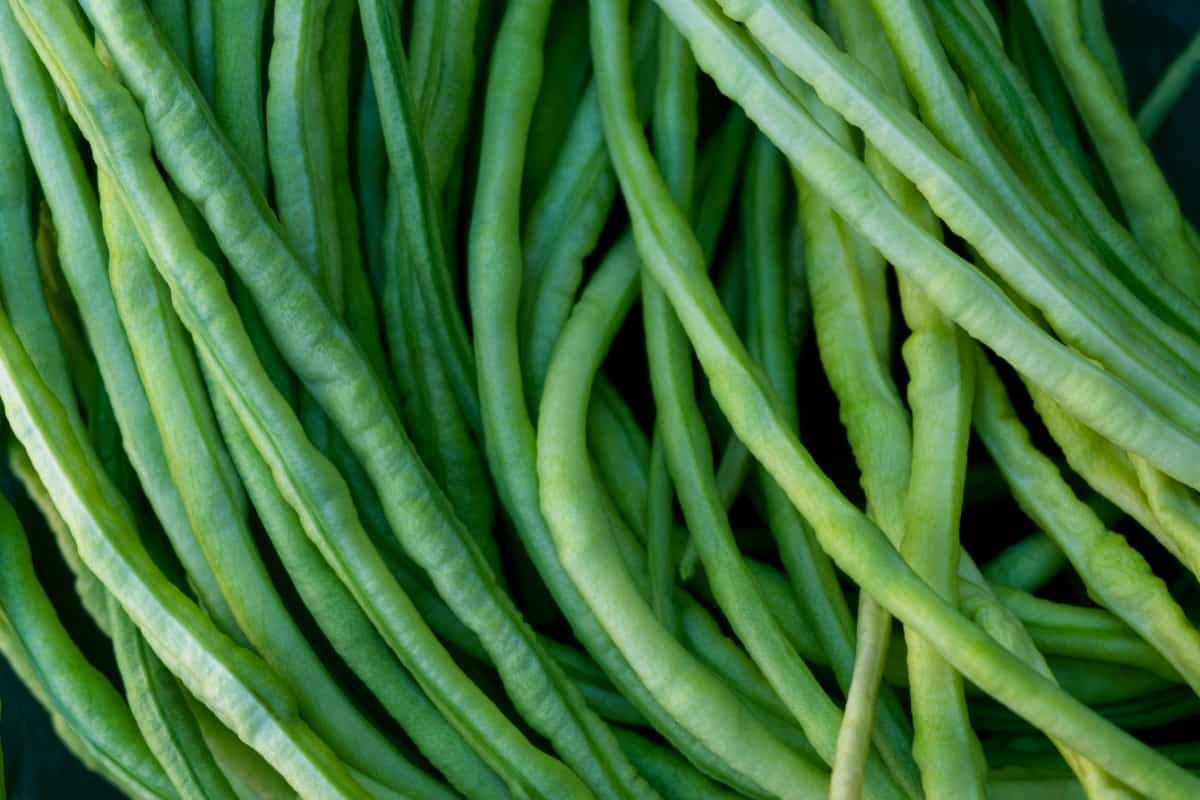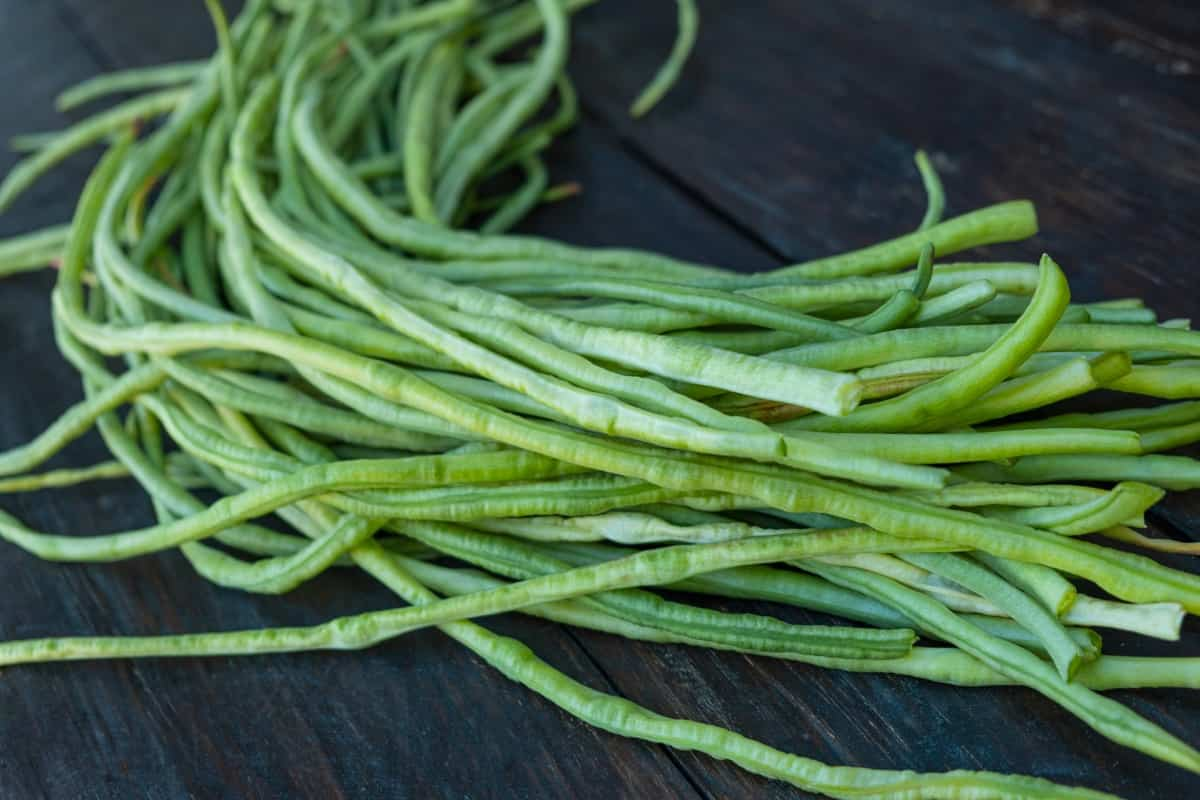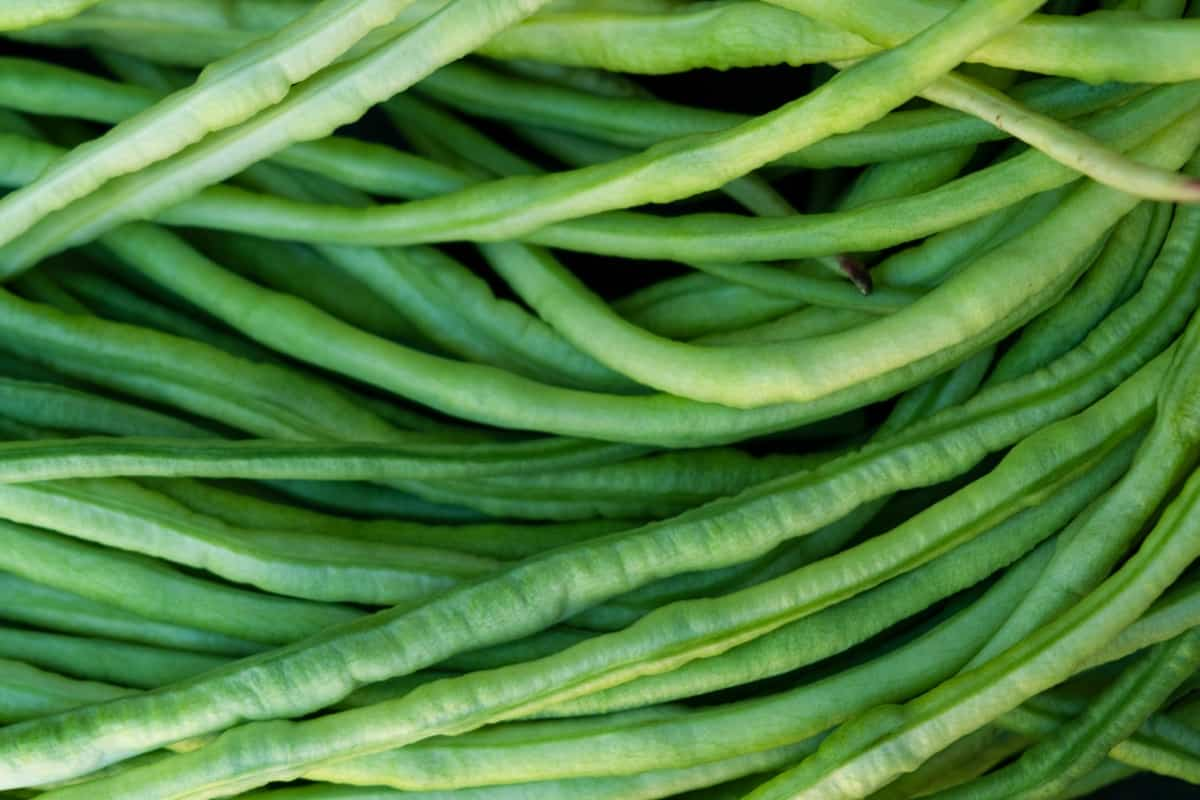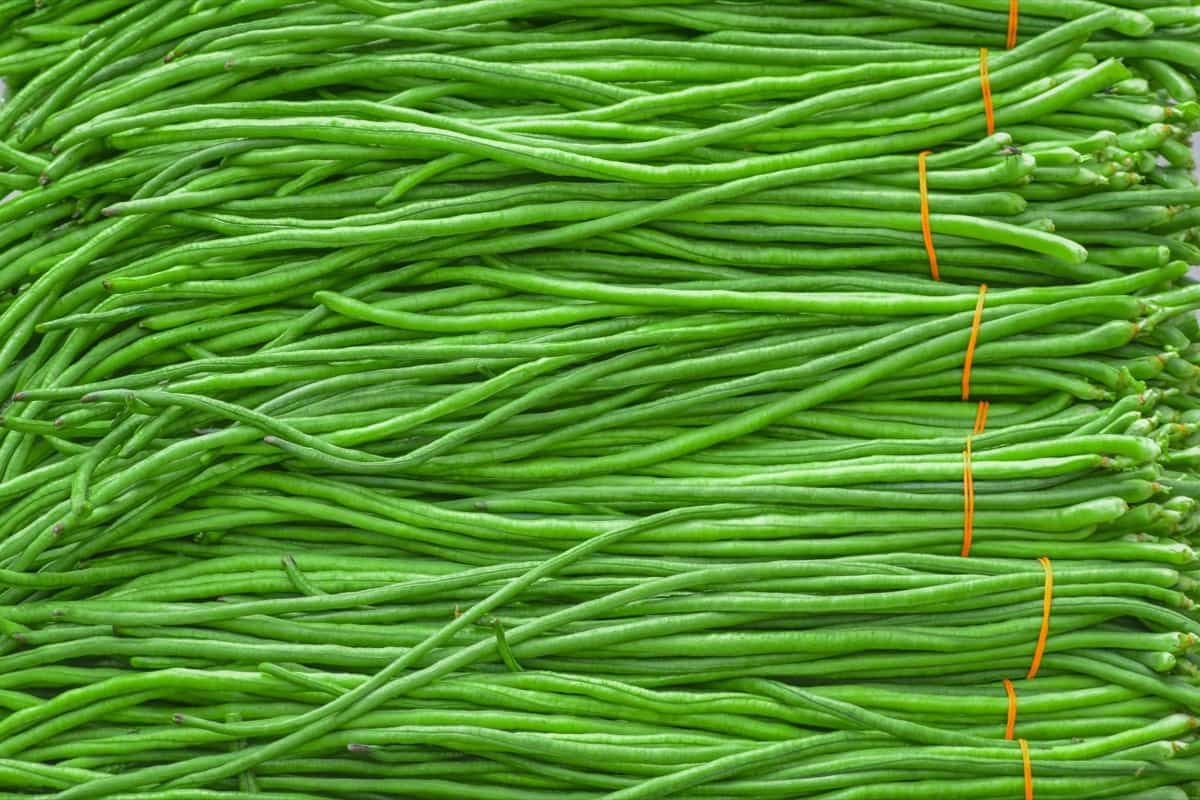Growing and caring for Yardlong Beans (asparagus Beans) from seed can be a fun, rewarding experience. You can enjoy fresh asparagus straight from your garden with just a little effort and patience. Remember to choose a location with plenty of sunlight and well-draining soil, provide your plants with regular watering and fertilizing, and check for any signs of pests or disease. With these simple steps, anyone can grow and care for Yardlong Beans.

How to Grow and Care for Yardlong Beans/Asparagus Beans From Seed
Types of Yardlong Beans
- Liana – Liana is one of the most popular types of Yardlong Beans. Liana plants are vigorous climbers that can grow up to 9 feet tall. The pods are light green when young and turn dark green as they mature. When fully ripe, the seeds inside the pod turn a creamy white color.
- Purple Podded – Regarding Yardlong Beans, the Purple Podded variety is a popular choice among gardeners and food enthusiasts. As the name suggests, this type of Bean produces long, slender pods with a deep purple hue. Aside from their striking looks, Purple Podded Yardlong Beans are known for their delicious flavor.
- Red Noodle – Red Noodle is a unique and visually appealing variety of Yardlong Beans. As the name suggests, these Beans are bright red and have a long, slender shape resembling noodles.
Container Size Suitable for Growing Yardlong Beans
Yardlong Beans can be grown in containers, making them a great option for those with limited space. Choose one at least 12 inches deep and wide when choosing a container size. This will give the roots enough room to grow and develop properly. It’s important to note that Yardlong Beans have long vines up to 10 feet long. Therefore, you may need a trellis or support system for the plant to climb on as it grows taller.
Propagating Yardlong Beans from Seed
Propagating Yardlong Beans from seed is a great way to start growing this nutritious and flavorful vegetable. To begin, select high-quality seeds for planting. Before planting, soak the seeds in water overnight to help speed up germination. This will also help soften the seed’s outer shell, which can sometimes be hard and resistant to sprouting. Next, prepare your soil by loosening it with a garden fork or tiller. Yardlong Beans prefer sandy loam soil that is well-draining and rich in organic matter.
Sow your seeds directly into the prepared soil at about 1 inch deep with spacing between each seed 4-6 inches apart. While sowing, ensure you sow them vertically, as it helps them grow quickly. The optimal temperature for Yardlong Bean germination is around 27°C. The seeds typically sprout within 7-10 days at this temperature. However, germination may be delayed or prevented altogether if temperatures dip below 15°C or rise above 32°C.
Once they have sprouted above ground level, give them plenty of sunlight (around 6-8 hours per day) until their first leaves appear. To ensure healthy growth throughout its life cycle, use organic fertilizers like compost tea mixed with fish emulsion every few weeks and watering, especially during dry spells.
In case you missed it: Top 19 Best Fast-Growing Trees to Plant in Your Garden

Transplanting Yardlong Beans Seedlings
Transplanting Yardlong Bean seedlings is a crucial step in the growth process. Once your seedlings have reached about 3-4 inches tall, it’s time to transplant them into larger containers or outdoors. Before transplanting, thoroughly water your seedlings and prepare the new container or ground for planting. When choosing a container or area in the ground, ensure enough space for the Beans to grow long vines.
Dig a hole deep enough for the roots of your seedling and gently remove it from its previous container. Place it into the new hole and cover it with soil, careful not to damage any part of the plant. After planting, continue to water regularly and support growing vines if necessary. It’s important to avoid over-watering as this can lead to root rot. If you give them the proper care, they will adjust quickly and continue growing strong.
Yardlong Beans Plant Care
Climate Suitable for Growing Yardlong Beans
Yardlong Beans are a warm-weather crop that thrives in hot and humid climates. These Asian vegetables prefer temperatures between 21 to 30 °C for optimum growth. They are heat-tolerant plants, making them ideal for tropical regions. The humidity levels of your region also play a significant role in determining whether Yardlong Beans will grow successfully.
High humidity helps keep the soil moist and provides ample moisture for plant transpiration, which is essential during flowering and fruit development. Additionally, being legumes means that they require adequate sunlight exposure throughout their life cycle to produce healthy pods. Therefore, choosing a location with full sun exposure is important when planting seeds or seedlings.
Soil Requirement for Growing Yardlong Beans
Yardlong Beans require well-draining soil that is rich in organic matter. Choosing a location with plenty of sun exposure is important for the best growth and yield. The soil pH should be between 6.0-7.5, which is slightly acidic to neutral. Before planting your Yardlong Bean seeds or seedlings, loosen the soil to a depth of at least six inches and amend it with compost or aged manure.
In case you missed it: Soil Borne Diseases and How to Treat Them Effectively: Control and Prevention Methods

This will help improve drainage and provide essential nutrients for healthy plant growth. Consider adding sand or perlite to improve drainage if you have heavy clay soils. On the other hand, if your soil is too sandy, you can add peat moss or coconut coir to help retain moisture.
Water Requirement for Growing Yardlong Beans
Yardlong Bean plants require moderate to high water levels throughout their growing season. However, it’s important to avoid overwatering as this can lead to root rot and other diseases. When watering your Yardlong Bean plants, keep the soil evenly moist but not soggy. Depending on your climate and soil type, you may need to water every 2-3 days during hot weather or less frequently in cooler conditions.
Be sure to water deeply so the moisture reaches the roots rather than just sitting on top of the soil. A drip irrigation system or soaker hose can help ensure even watering while minimizing evaporation loss. During periods of heavy rainfall or if you’ve had an extended period without sun, it’s best to hold off on watering until the soil has dried out slightly. This will prevent any potential issues with fungal diseases caused by excess moisture.
Fertilizer Requirement for Growing Yardlong Beans
Providing the right nutrients is important to ensure that your Yardlong Beans are healthy and thriving. Fertilization plays a crucial role in the growth of Yardlong Beans. Before planting your seeds or seedlings, add compost or well-rotted manure to prepare the soil. These organic materials will help improve soil fertility and structure. Once planted, apply a balanced fertilizer every four to six weeks during the growing season. Look for fertilizers with equal amounts of nitrogen, phosphorus, and potassium.
In addition to NPK fertilizers, consider supplementing with calcium and magnesium. Calcium helps prevent blossom-end rot, while magnesium aids in chlorophyll production for greener leaves. Avoid using high-nitrogen synthetic fertilizers as they can damage beneficial soil microorganisms responsible for nutrient cycling. Always follow package instructions when applying fertilizers and avoid over-application, which can lead to burning plant roots.
Pruning Yardlong Beans Plant
Pruning is an essential aspect of growing healthy Yardlong Beans. It helps to promote bushier and more productive plants by removing dead, damaged, or diseased plant parts. Additionally, it encourages the growth of new shoots that produce more flowers and fruits. The best time to prune your Yardlong Beans is when they are young and still developing their structure. You can start by pinching off the tips of the vines once they reach 12-18 inches long. This will encourage branching and make for a fuller plant.
You should also remove any lateral shoots that develop on the main stem below where you pinched off the tip. These side shoots will compete with the main vine for nutrients, water, and sunlight. Another important pruning technique is to remove any yellowing leaves or branches as they appear throughout the season. This improves airflow around your plants and reduces fungal diseases’ risk from spreading through infected leaves.
In case you missed it: Best Fertilizer for Green Beans: Homemade, Natural, Organic, NPK, Compost Manure, and Schedule

Training Yardlong Beans plant
Training Yardlong Beans is an important aspect of their care. It involves guiding the vines to grow in a particular direction and supporting them so they can climb and reach their full potential. One way to train Yardlong Beans is by using trellises or stakes. These structures provide a framework for the vines to grow on, keeping them off the ground and reducing the risk of disease or pests.
As the plants grow, gently guide them along the trellis or stake so that they continue to climb upwards. It’s important not to let your Yardlong Bean vines become too crowded, which can lead to poor air circulation and increase disease susceptibility. Regular pruning of dead leaves or damaged stems will help maintain healthy growth patterns.
Yardlong Beans Plant Care in Winter
During winter, taking special care of your Yardlong Beans is important to ensure they survive and thrive come springtime. The first step in caring for your Yardlong Beans during winter is to protect them from frost. Cover your plants with a layer of mulch or straw to prevent frost damage. This will help insulate the soil and protect the roots from freezing temperatures.
You can also use row covers or blankets to provide additional protection. In addition to protecting your plants from frost, ensuring they have enough water during winter is important. While you don’t want to overwater your Yardlong Beans (as this can lead to root rot), you should still give them a good drink every few weeks if there is no rainfall.
Pests and Diseases of Yardlong Beans and Their Control
Yardlong Beans are susceptible to pests that can damage and reduce harvest yield. It is important to identify these pests early on and take preventive measures before they cause significant harm. One of the most common pests in Yardlong Beans is aphids. They suck sap from the leaves, which causes them to wilt and eventually die. These tiny insects reproduce quickly, so it’s best to control them immediately. You can use neem oil spray, which suffocates the respiratory system.
In case you missed it: Best Fertilizer for Green Beans: Homemade, Natural, Organic, NPK, Compost Manure, and Schedule

Another pest that attacks Yardlong Beans is the Bean Beetle. The adults chew holes in leaves while their larvae feed on roots, causing stunted growth or even death of plants. Handpicking and destroying infected plants help minimize their spread, while spraying with insecticides like pyrethrin also helps control Bean beetles. Spider mites may also attack Yardlong Beans by sucking out chlorophyll from leaves resulting in a yellowish appearance. To prevent an infestation, maintain adequate moisture levels around your garden bed using mulch or drip irrigation since spider mites thrive under dry conditions.
Insects aren’t the only problem for Yardlong Beans; fungal diseases such as powdery mildew can occur too. This disease spreads rapidly during warm, humid weather causing white spots across plant surfaces, but fungicide sprays containing potassium bicarbonate solution are effective against this disease. Keeping your garden free from diseases should always be a top priority when growing crops, including Yardlong Beans. Being vigilant about prevention measures like proper watering techniques and adequate spacing between plants will help reduce the risk of these issues while ensuring successful yields at harvest time.
Harvesting Yardlong Beans
Harvesting Yardlong Beans is a rewarding and satisfying experience for any gardener. These delicious and nutritious veggies are ready to harvest when they reach their full size, up to 12 inches long. Inspect the pods carefully and look for signs of maturity. The Beans inside should feel firm and plump.
Gently pull the pod off the vine with your fingers or scissors. Be careful not to damage the plant while harvesting. If some pods aren’t quite mature yet but need more time on the plant, leave them on so they can continue growing. Fourthly, picking your Yardlong Beans regularly is important as this will encourage new growth and keep your plants healthy.
In case you missed it: Growing Green Beans from Seed to Harvest: How to Start from Scratch, A Detailed Guide for Beginners

Conclusion
Growing and caring for Yardlong Beans from seed is a rewarding experience that can provide fresh, healthy produce all year round. With the right conditions, soil, water, and fertilizer requirements met, as well as regular pruning and training of the plant, anyone can enjoy a bountiful harvest of these delicious veggies. It’s important to remember that patience is key when growing any vegetable. While Yardlong Beans may take longer than some plants to reach maturity and produce fruit, their unique flavor, and nutritional benefits make them worth the wait.
- How to Grow Tomatoes Organically at Home: A Comprehensive Guide
- Organic Gardening on a Budget: Low-Cost Methods and Materials
- Gongura Seed Germination and Planting Methods
- Cabbage Seed Germination and Selection
- Broccoli Seed Germination and Selection
- Asparagus Seed Germination and Variety Selection
- Seasonal Flower Gardening: Best Practices for Spring, Summer, Fall, and Winter
- How to Grow Hibiscus from Flower
- Plantation Ideas for Home Decoration: A Beginners Guide
- Flower Garden Designs and Layouts for Beginners
- Planting and Spacing Techniques in Papaya: A Beginner’s Guide
- Growing Gold: Essential Techniques for Planting Pineapples
- How to Make Kalanchoe Plant Bushy: Home Remedies and Solutions
- 11 Reasons Why Your Gardenia is Not Blooming: Home Remedies and Solutions
- Eco Elegance: The Guide to Designing a Drought-Tolerant Landscape
- Gardening on a Slope: Strategies for Hillside Landscaping
- Nourish and Flourish: Top Organic Mulches for Thriving House Plants
- Everything You Want to Know about Indian Mogra Flower: Discover Uses and Growing
- Green Thumb Success: Expert Tips for Cultivating Greenhouse Pumpkins All Year Round
- Maximize Growth & Flavor: The Ultimate Guide to Companion Planting in Herb Gardens
- How to Control Rhododendron Problems Naturally: Home Remedies and Organic Ways to Fix Them
- Natural Magic: The Remarkable Benefits of Cinnamon for Plants
- Best Steps to Revive Dying Tulip with Natural and Organic Treatment
- 10 Reasons Why Your Angel Trumpet is Not Blooming: Remedies and Treatment
- How to Fix Periwinkle Leaf and Flower-Related Problems: Natural Remedies and Solutions
- How to Fix Zinnias Leaf and Flower Problems: Discover Natural and Home Remedies
- Organic Steps to Induce Lemon Tree Flowers: A Comprehensive Guide
- Bloom Booster: Crafting the Perfect Homemade Bougainvillea Fertilizer
- Optimizing Growth: A Guide to Applying NPK Fertilizer for Potted Plants
- 10 Best Homemade Fertilizers for Rubber Plant: DIY Recipes and Application Method
- How to Boost Female Pumpkin Flowers: Effective Steps for More Flowers and High Yields
- Transform Your Indoor Garden: Top Benefits of Pink Salt for Houseplants
- 10 Best Homemade Fertilizers for Peacock Plants (Calathea): Easy DIY Guide
- Unlock Blooms: 9 Reasons Why Your Potted Chrysanthemum is Not Blooming
- 8 Reasons Why Your Potted Hibiscus is Not Blooming: Fix it with Simple Solutions
- Unlock Blooms: 9 Key Reasons Your Potted Frangipani Won’t Flower